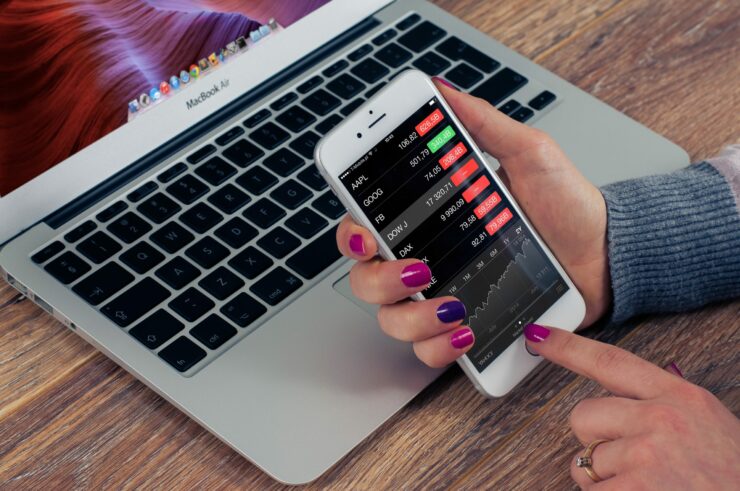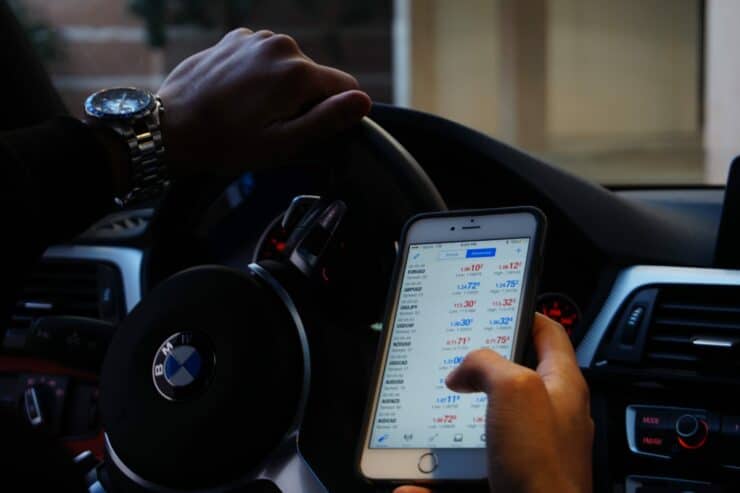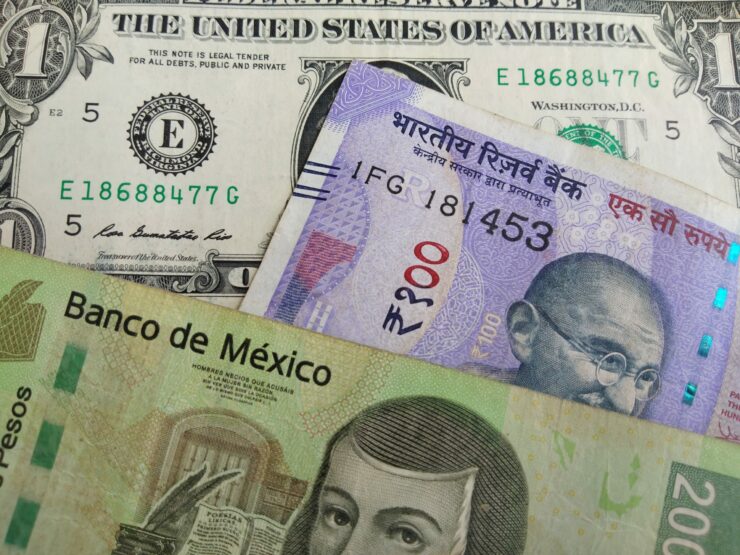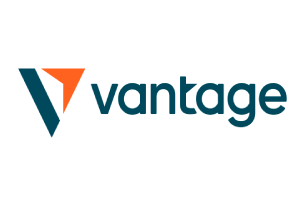The best forex trading apps and the landscape of buying and selling assets have changed tremendously since it entered the online space. Until then, the traditional set up of trade required you to call your broker to enter positions on your behalf.
3
Payment methods
Trading platforms
Regulated by
Support
Min.Deposit
Leverage max
Currency Pairs
Classification
Mobile App
Min.Deposit
$100
Spread min.
Variables pips
Leverage max
100
Currency Pairs
40
Trading platforms
Funding Methods





Regulated by
FCA
What you can trade
Forex
Indices
Actions
Cryptocurrencies
Raw Materials
Average spread
EUR/GBP
-
EUR/USD
-
EUR/JPY
0.3
EUR/CHF
0.2
GBP/USD
0.0
GBP/JPY
0.1
GBP/CHF
0.3
USD/JPY
-
USD/CHF
0.2
CHF/JPY
0.3
Additional Fee
Continuous rate
Variables
Conversión
Variables pips
Regulation
Yes
FCA
No
CYSEC
No
ASIC
No
CFTC
No
NFA
No
BAFIN
No
CMA
No
SCB
No
DFSA
No
CBFSAI
No
BVIFSC
No
FSCA
No
FSA
No
FFAJ
No
ADGM
No
FRSA
71% of retail investor accounts lose money when trading CFDs with this provider.
Min.Deposit
$100
Spread min.
- pips
Leverage max
400
Currency Pairs
50
Trading platforms
Funding Methods




Regulated by
CYSECASICCBFSAIBVIFSCFSCAFSAFFAJADGMFRSA
What you can trade
Forex
Indices
Actions
Cryptocurrencies
Raw Materials
Etfs
Average spread
EUR/GBP
1
EUR/USD
0.9
EUR/JPY
1
EUR/CHF
1
GBP/USD
1
GBP/JPY
1
GBP/CHF
1
USD/JPY
-
USD/CHF
1
CHF/JPY
1
Additional Fee
Continuous rate
-
Conversión
- pips
Regulation
No
FCA
Yes
CYSEC
Yes
ASIC
No
CFTC
No
NFA
No
BAFIN
No
CMA
No
SCB
No
DFSA
Yes
CBFSAI
Yes
BVIFSC
Yes
FSCA
Yes
FSA
Yes
FFAJ
Yes
ADGM
Yes
FRSA
71% of retail investor accounts lose money when trading CFDs with this provider.
Min.Deposit
$50
Spread min.
- pips
Leverage max
500
Currency Pairs
40
Trading platforms
Funding Methods




What you can trade
Forex
Indices
Actions
Raw Materials
Average spread
EUR/GBP
-
EUR/USD
-
EUR/JPY
-
EUR/CHF
-
GBP/USD
-
GBP/JPY
-
GBP/CHF
-
USD/JPY
-
USD/CHF
-
CHF/JPY
-
Additional Fee
Continuous rate
-
Conversión
- pips
Regulation
No
FCA
No
CYSEC
No
ASIC
No
CFTC
No
NFA
No
BAFIN
No
CMA
No
SCB
No
DFSA
No
CBFSAI
No
BVIFSC
No
FSCA
No
FSA
No
FFAJ
No
ADGM
No
FRSA
71% of retail investor accounts lose money when trading CFDs with this provider.
The advancements in technology have since made it convenient beyond imagination to execute your trading choices just with a few clicks.
Our Forex Signals
1 - month
Subscription
 Up to 15 signals daily
Up to 15 signals daily 76% success rate
76% success rate Entry, take profit & stop loss
Entry, take profit & stop loss Amount to risk per trade
Amount to risk per trade Risk reward ratio
Risk reward ratiomonth
3 - month
Subscription
 Up to 15 signals daily
Up to 15 signals daily 76% success rate
76% success rate Entry, take profit & stop loss
Entry, take profit & stop loss Amount to risk per trade
Amount to risk per trade Risk reward ratio
Risk reward ratiomonth
 Most popular
Most popular
6 - month
Subscription
 Up to 15 signals daily
Up to 15 signals daily 76% success rate
76% success rate Entry, take profit & stop loss
Entry, take profit & stop loss Amount to risk per trade
Amount to risk per trade Risk reward ratio
Risk reward ratiomonth
Lifetime
Subscription
 Up to 15 signals daily
Up to 15 signals daily 76% success rate
76% success rate Entry, take profit & stop loss
Entry, take profit & stop loss Amount to risk per trade
Amount to risk per trade Risk reward ratio
Risk reward ratioSeparate Swing Trading Group
 Up to 3 signals weekly
Up to 3 signals weekly 76% success rate
76% success rate Entry, take profit & stop loss
Entry, take profit & stop loss Amount to risk per trade
Amount to risk per trade Risk reward ratio
Risk reward ratiomonth
1 - month
Subscription
 Up to 15 signals daily
Up to 15 signals daily 76% success rate
76% success rate Entry, take profit & stop loss
Entry, take profit & stop loss Amount to risk per trade
Amount to risk per trade Risk reward ratio
Risk reward ratiotime
Today, the investment sector has taken one more step ahead with the launch of trading apps. The best trading apps allow you to gather information regarding your assets, track their movement, place your orders, and manage them – no matter where you are.
Regardless of which niche you are focused on, be it in stocks, indices, forex, commodities, or cryptocurrencies – you can find an app that serves all domains or has exclusive features for one specific financial instrument. The internet has a myriad of choices, suited for the personal and professional interests of traders of all levels.
Now, the critical question is which forex trading app is right for you? In this guide, we aim to find out!
Eightcap - Regulated Platform With Tight Spreads

- Minimum deposit of just 250 USD to get lifetime access to all the VIP channels
- Use our Secure and Encrypted Infrastructure
- Spreads from 0.0 pips on Raw Accounts
- Trade on the Award-Winning MT4 & MT5 Platforms
- Multi-jurisdictional Regulation
- No Commission Trading on Standard Accounts

What are Trading Apps?
With hundreds of thousands of dedicated mobile applications now available to download and install at the click of a button – it makes sense that this has since extended to the investment arena. Trading apps are exactly what the name suggests. They enable you to make investment choices and carry them out through a mobile device.
Nowadays, you will find virtually every trading tool and feature on a trading app that you would otherwise find at a desktop website. However, you also need to bear in mind that they are not designed to function as independent tools. On the contrary, there are some aspects that, as investors, you will need to access from a fully-comprehensive brokerage service.

Trading apps are particularly useful if you do not have access to a desktop at all times, as they are designed to help you navigate easily through the broker’s vast number of tradable assets. Even though you will be able to access the trading site through your smartphone, the smaller screen size might make it somewhat challenging to perform more elaborate research and analysis.
Trading Apps are Crucial
Across all financial instruments available for trading, forex is considered one of the most liquid markets in the world. Volatility, being one of the most interesting metrics that rule the investment markets, highly favours forex.
You can expect to see continuous movement in the market in every major currency pair on any given day. These assets are highly vulnerable to events, and other economic news – as traders are always searching for rapidly changing markets. As such, forex is highly preferred by those that want to actively buy and financial instruments.
Due to this high volatility, forex traders need to constantly lookout for changes in the market. They need access to charts, quotes, and above all, their trading accounts at the click of a button. Hence, finding the best forex trading app is of utmost importance.
Nearly all of the top forex trading platforms and brokers provide an exclusive trading app. Some also allow you to use the app without having an account on their trading platform. This will, however, only allow you to browse the trading arena and not actually place orders. This includes access to information and technical resources such as MT4.
How to Use a Forex Trading App?
Using a trading app is not so different from using a trading site online. They include the same features and the same process of setting up your account. The only striking difference would be in the interface and how you navigate through the platform.
Here we have a step-by-step guide on how you can begin your forex investment career via a mobile trading app.
1. Find the best forex trading app
Every trading app might appear to have the same set of features. Yet, they are all unique, differing in value and efficiency. Your first step is to identify the best forex trading app that most suits your individual trading style.
In the later sections of this guide, we have provided an in-depth overview of how to pick the best forex trading app. We will further discuss in detail the factors such as regulation, commissions, fees, and overall performance.
At the very least, you need an app that is compatible with your mobile device. If you are switching between a tablet, a phone, and a computer, you need an app that can provide a seamless experience across all mediums.
2. Instal the trading app
Finding the best trading app is the toughest part of the process. The rest works as seamlessly as installing any other phone app. The majority of trading sites will have direct links redirecting you to their official apps. If not, you can also search for them through the Android or iOS app stores.
At this point, you should ensure that you are downloading the licensed and original version of apps. It is not uncommon to come across imitations or fake versions of such trading apps. Since you are essentially entrusting your capital into the hands of a brokerage firm, you need to ensure you are doing this through the authentic version of the app.
Once you download and install the app, the next step is to open your account.
3. Set up your trading account
If you already have an account with the corresponding trading site, then you will only have to log in with your credentials. If not, you might be required to first open an account with the broker site.
Apart from your email address and password, trading platforms also require you to provide personal information such as your full name, home address, date of birth, and phone number. Most importantly, you will also have to provide a tax identification number.

Crucially, broker sites also need to know about your prior experience in the investment industry. This also gives the provider an overview of your preferred assets, as well as the amount of leverage that you are suitable for.
4. Get your identity verified
The identity verification procedure depends on your country. For instance, in the UK, brokers have to follow the mandatory process called Know Your Customer (KYC) to verify the identity and suitability of entering into a business relationship with a client.
The process is easy and efficient. All you are expected to do is to provide a government-issued ID that is valid in the said country and upload the document. As some trading apps also have to verify your address, you might need to provide additional documentation such as rent receipts, bills, or a bank statement.
5. Add funds to your account
In order to make the most of trading apps, you also need to have capital deposited in your trading account. You can do this only when your account is thoroughly verified by the trading platform (this often takes just minutes). Once it is, you can then add money with ease.
The best forex trading apps offer a variety of payment methods for users. This includes credit or debit card payments, e-wallets, or even a wire transfer.
6. Begin trading on the app
With a sufficient balance in your account, now all that is left for you is to start buying and selling currency pairs. Since trading apps provide access to more than one asset, you can find your preference by using the search function. For specific forex trades, you can enter currency pairs such as USD/EUR, and you will be redirected to the respective trading page.
If you are a beginner, it is always recommended to start trading in small denominations before moving on to larger trades. Once you are familiar with the app and experienced with forex trading, only then should you consider increasing your stakes.
How to Find the Best Forex Trading Apps?
The answer to which is the best forex trading app will depend on your trading goals and experience. While beginners might find straightforward apps more appealing, the seasoned trader might be looking for sophistication that offers them enhanced market insight .
If you are struggling to find an app that meets your needs, here are some attributes you need to consider and compare. For those who do not have the liberty of time, we also discuss our preferred forex trading apps towards the end of this page.
1. Is the app compatible?
As we mentioned earlier, one of the main reasons why you are likely looking for a trading app is because of convenience. As such, unless it is compatible with the device you have at your disposal, you will need to stick with the website version of your chosen forex broker.
On the bright side, most established trading sites will develop apps that are compatible with both Android and iOS devices. However, if you’re using an alternative operating system – you might be out of luck.
2. Is the app regulated?
For any trader, the first metric that must be considered when picking a trading site is credibility. At the forefront of this are the licensing bodies that the broker is regulated by. For example, platforms in the UK have to be regulated by the FCA. In Australia, it is ASIC, CySEC in Cyprus, BaFin in Germany, and so on.
If the trading app does not highlight their licensing bodies, this should be your first red flag. In other words, when you are trading with large amounts through these platforms, it is your responsibility to ensure that your money and interests are safeguarded. If you are unable to find this information on the trading app, the regulator’s register will be able to confirm this through a quick search. If not, it is best to avoid the platform and its respective app.
3. What payment policies in place?
Trading sites and apps have individual policies on the initial deposit amount and how you can make them. Today, unlike desktop sites, phone apps accept payments through Google and Apple pay – which is well worth considering.
Some users prefer this over credit cards or bank account deposits – as there is no requirement to enter sensitive financial information into the app. Optionally, some trading sites also offer support for e-wallets such as PayPal or Neteller. You also need to check whether the app charges you fees for making a deposit.
4. What assets can you trade?
Trading apps are available not only for forex but for every other financial instrument too. You will find that new-age trading apps typically address several asset classes as opposed to sticking exclusively to forex. You can look for each asset class and what services the trading platform offers before making your decision.
Additionally, you also have to look into the diversity of assets available in each financial instrument. For example, while some forex trading apps provide support only for major pairs only, others give you access to dozens of minors and exotics.
5. What fees do you have to pay?
Trading platforms make money from commissions and the spread and thus – a small segment of each buy and sell order goes to the respective platform. As such, investors have to look for trading apps that offer tight spreads. This is the gap between the asking price and the selling price. The lower the spread is, the more of your profit you get to keep.
Some trading platforms offer no commissions but go a little higher on spreads. It is thus crucial to weigh in and compare the spread rates and whether or not they charge a commission. Apart from this, you will also have to pay overnight fees for each day that you keep the forex position open.
6. How user-friendly is the app?
For many users, the interface of the app plays a significant role in the decision-making process. Even though the best forex trading apps might come packed with advanced features and tools, if it is not user-friendly, it might be worth avoiding. Instead, you will be forced to waste time learning how the app functions – rather than spending your time improving your investment strategies.

7. How dependable is customer support?
If the trading site has a reliable client support team, you should expect the same level of service through the app. At the forefront of this is being able to speak with a support agent in real-time via a live chat facility. This avoids the need to call the broker up.
Why Should You Use an MT4 Trading app?
MetaTrader4 has evolved to become the sharpest tool in the box for the most seasoned of traders. Though it is applicable for trading across all financial instruments, it works extremely well with forex. MT4 is hugely popular since it allows users to employ their trading preferences with ease. The software also allows users to automate their trading based on the algorithms and autonomous robots. This way, the software will automatically open and close positions as per the set of parameters you set through MT4.
Additionally, you can analyze price fluctuations and interpret trading graphs. MT4 is a necessary tool that can help facilitate all remote investment strategies – so this something that is well worth considering.
Features of using the MT4 forex trading app includes:
- Access to data from anywhere
- Allows you to enter and exit trades instantly
- Download history of currency pairs
- Responsive design for phone screens
- Includes all highlighted features of desktop versions
- Manage your funds right from the phone app
- Tools such as charts and graphs to understand the movement of currencies
Crucially, the MT4 app ensures that the process of trading and performing technical analysis is not hindered by smaller screen size.
Types of Assets Available on a Trading App
Mobile trading apps can connect you to the same extensive network of financial instruments available through the respective brokerage sites. Although your preferred asset class might be forex, it is well worth exploring what other financial instruments you will have at your disposal.
Equities and Shares
Individual equities are essentially shares that represent ownership in publicly held companies. Trades of these shares are facilitated through stock exchanges all over the world. You profit when there is an appreciation or depreciation in the value of these shares.
Equities are also therefore prone to the events and news that would impact the position of the underlying company. If you want to invest in international shares, you need to make sure the mobile trading platform give you access to the specific exchange.
Indices
If you do not have the required experience to speculate on individual equities, then the next best alternative is indices. These are stocks of different companies basketed as a group. Each group will have several companies mostly classified together based on their industry.

ETFs
Exchange-Traded Funds are traded similar to stocks, but usually in a band of diverse assets. The value of ETFs changes across the day, depending on the underlying assets it is tracking. As such, there are plenty of opportunities to go long or short throughout the trading day. Using a trading app for this purpose would be a notable choice as you can continuously monitor how the assets are performing.
Commodities
Commodities are classified into three sectors – energy, metal, and agricultural products. The prices of these will vary significantly throughout the day. The majority of trading apps give you access to dozens of commodity instruments. This might include gold, oil, gas, and wheat.
Cryptocurrencies
The popularity of cryptocurrencies in the global trading arena has surged in the last few years. Today, both developers and investors are keen to design apps that cater exclusively to the crypto trading industry.
Not every trading site has ventured into this domain yet. Traditional brokers often rely on CFDs to execute trades on digital currencies. As such, if you do want to get into cryptocurrency trading, you will have access to leverage and short-selling facilities.
The Best Forex Trading Apps of 2022 and 2023
Up to this point of our in-depth guide, we have covered in detail what to look for in a forex app. However, not everyone is able to invest enough time to find the right one.
After reviewing the aspects of tradable assets, fees, and features – we have rounded up a list of five well-rounded trading apps that will address all your investing needs.
1. AVATrade – 2 x $200 Welcome Bonuses
If you are looking for a one-shop-stop for all your investment needs, AVATrade perfectly fits your needs with regulatory licenses across numerous jurisdictions. The trading platform is one of the most established brokers in the online space, and subsequently operating since 2006. The site gives you access to over 250 financial instruments - including a fully-fledged forex arena.
AVATrade is available across desktop, tablet, and mobile devices, each with a user-friendly interface and innovative features. You can use MT4 and MT5, along with the exclusive AVATrade web-trader which you can access through your mobile phone. The platform excels in all areas, especially when it comes to a seamless mobile trading experience.
.

- 20% welcome bonus of up to $10,000
- Minimum deposit $100
- Verify your account before the bonus is credited
2. VantageFX – Ultra-Low Spreads
VantageFX VFSC under Section 4 of the Financial Dealers Licensing Act that offers heaps of financial instruments. All in the form of CFDs - this covers shares, indices, and commodities.
Open and trade on a Vantage RAW ECN account to get some of the lowest spreads in the business. Trade on institutional-grade liquidity that is obtained directly from some of the top institutions in the world without any markup being added at our end. No longer the exclusive province of hedge funds, everyone now has access to this liquidity and tight spreads for as little as $0.
Some of the lowest spreads in the market may be found if you decide to open and trade on a Vantage RAW ECN account. Trade using institutional-grade liquidity that is sourced directly from some of the top institutions in the world with zero markup added. This level of liquidity and availability of thin spreads down to zero are no longer the exclusive purview of hedge funds.

- The Lowest Trading Costs
- Minimum deposit $50
- Leverage up to 500:1
Conclusion
Trading apps have opened up the realm of forex to a broader audience. The forex market might still be new for many traders, and for the very same reasons, the abundance of resources offered by these trading apps are highly likely to promote interest.
If you have read through our guide in full – you should now be able to find the best forex trading apps that allow you to trade on the move. Ultimately, you need to ensure that each app works for your personal requirements, and that your chosen platform is licensed, offers reasonable fees, and dependable customer support.
AvaTrade - Established Broker With Commission-Free Trades

- Minimum deposit of just 250 USD to get lifetime access to all the VIP channels
- Awarded Best Global MT4 Forex Broker
- Pay 0% on all CFD instruments
- Thousands of CFD assets to trade
- Leverage facilities available
- Instantly deposit funds with a debit/credit card

FAQs
How can I deposit money on my trading app?
What is the maximum leverage you can get on mobile trading apps?
What is the minimum balance I have to maintain in a trading app?
Can I download mobile trading apps on my Windows phone?
How can I reach customer service through a mobile trading app?
I already use a trading site, how can I find their mobile app?
Can I receive bonuses through mobile trading apps?

